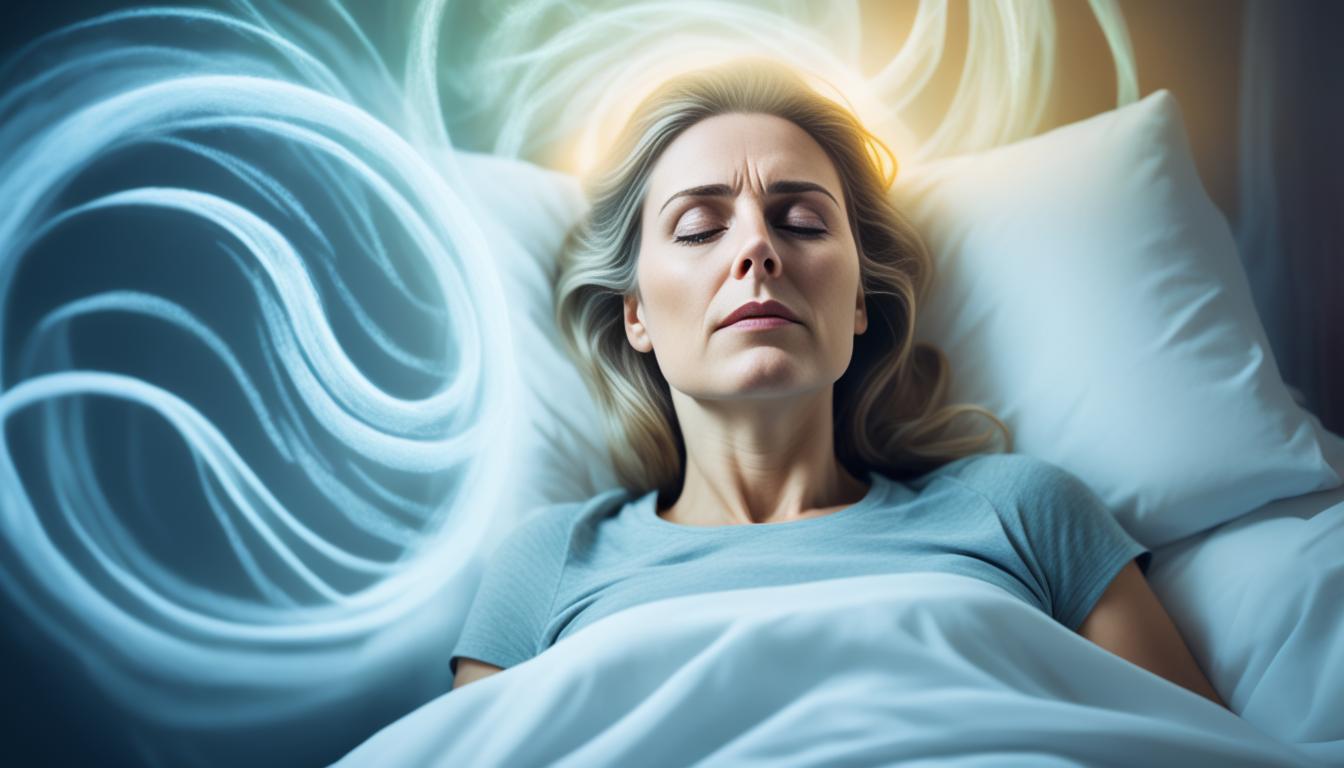Anorgasmia affects women, making it hard or impossible to have an orgasm. This issue has various causes, both physical and mental. Knowing the symptoms and ways to treat it is key to helping women achieve better sexual satisfaction.
Key Takeaways:
- Anorgasmia is a condition that causes difficulty or the inability to achieve orgasm in women.
- It can be caused by physical factors such as hormonal imbalances or psychological factors such as anxiety or trauma.
- Diagnosis involves a thorough medical history, physical examination, and possibly laboratory tests to identify the underlying causes.
- Traditional treatments like therapy and medication can be effective, but innovative therapies like stem cell therapy are showing promise.
- Managing and overcoming anorgasmia may involve open communication, self-care practices, and seeking guidance from healthcare providers or therapists.
Understanding Anorgasmia in Women
Anorgasmia is difficulty in achieving orgasm for women. It’s tough and can make a woman feel less satisfied with sex. It can even affect her life in general.
There are different types of anorgasmia, including:
- Primary Anorgasmia: Women who have never achieved orgasm.
- Secondary Anorgasmia: Women who could orgasm before, but now they can’t.
- Situational Anorgasmia: Women who can’t orgasm in some situations or with certain people.
It’s key to know the different types and their causes to find the right treatment. Each type might be due to different reasons.
If anorgasmia is something you face, talking to a healthcare professional or sex therapist can help. They’ll ask about your symptoms and history. Then, they can identify the anorgasmia type and suggest treatment.
Keep reading to learn about the signs, causes, and how to treat anorgasmia in women.
Symptoms of Anorgasmia in Women
Anorgasmia means a woman can’t climax or finds it very hard. It affects her sexual happiness. Knowing these symptoms is key to help women deal with this issue.
1. Inability or Difficulty in Achieving Orgasm
The biggest sign is the struggle to reach orgasm. This happens even with sexual acts. Women may not feel pleasure, causing them to be disappointed or frustrated.
2. Decrease in Sexual Desire
Signs can also include less interest in sex. You might not want it as often. This lack of libido can make you less likely to start or join in sexual activities.
3. Reduced Arousal
Finding it hard to get turned on is another symptom. When arousal is low, reaching orgasm becomes tougher. This lowers the chance to enjoy sex fully.
4. Lack of Sexual Pleasure
Not feeling pleasure during sex is a key symptom. Some women can’t feel intense joy during sex. Missed pleasure affects enjoying intimate times.
To feel better and enjoy sex more, seek treatment for these symptoms. Talking openly with not only your partner but also doctors and therapists is crucial. Working together, you can find a way to improve this problem.
It’s important to get help for anorgasmia. With the right support and understanding, women can improve their sex lives. Overcoming anorgasmia is possible. It leads to a more satisfying sex life.
Causes of Anorgasmia in Women
Anorgasmia means a woman finds it hard to reach orgasm. It can be due to physical or psychological reasons.
Physical Causes of Anorgasmia
Physical factors like hormonal imbalances or certain medicines can lead to anorgasmia. Health issues like diabetes and surgeries can also make it tough. They mess with the body’s processes needed for orgasm.
Psychological Causes of Anorgasmia
Feelings and thoughts can play a big part in anorgasmia. Stress, anxiety, bad past experiences, and not liking your body can all stop you from enjoying sex. These mental blocks can keep you from getting in the mood or staying focused.
Figuring out what’s causing the anorgasmia is key to treating it. A full checkup is needed. It should look at both the body and the mind. This way, the right help can be given.
Understanding the reasons behind anorgasmia helps in providing the right treatment. Doctors can then create special plans to help women. This can bring hope and a better life to those affected.
Diagnosis of Anorgasmia in Women
Diagnosing anorgasmia in women requires checking their medical history and doing a physical exam. Sometimes, lab tests are needed. Healthcare providers collect a lot of information to figure out the cause. Then, they create a treatment plan.
Medical History
Doctors ask about the patient’s past, like surgeries or trauma, that could be linked to anorgasmia. They also talk about changes in sexual health over time. This includes looking at any psychological factors.
Physical Examination
Doctors may do a physical exam to check for any health issues causing anorgasmia. They look at the pelvic area for problems. They might also check hormone levels and other physical factors.
Laboratory Tests
Sometimes, lab tests are needed to check hormone levels or look for infections. These tests provide a full picture of the patient’s health. They help doctors decide on the best treatment.
| Diagnostic Methods for Anorgasmia in Women | Key Components |
|---|---|
| Medical History | Gathering information on medical conditions, surgeries, and trauma |
| Physical Examination | Evaluating the pelvic area for abnormalities or dysfunction |
| Laboratory Tests | Assessing hormone levels, checking for infections, and evaluating overall health markers |
Traditional Treatments for Anorgasmia in Women
Traditional treatments for anorgasmia often include therapy and medication. These methods deal with both the mind and body. They try to solve psychological and physical issues that might stop a woman from climaxing.
Therapy
Therapy is key in helping women overcome anorgasmia. Cognitive-behavioral therapy (CBT) is a big help. It focuses on spotting and changing negative thoughts. This can help with stress, anxiety, or bad experiences that affect sex.
Sex therapy is also useful. Sex therapists explain and address sexual problems. They suggest ways to make sex better. This includes talking openly and trying new things together.
Medication
Sometimes, doctors might give you medicines for anorgasmia. Antidepressants like SSRIs are often used. They can improve mood but might make climaxing hard. Other types of drugs might fix hormone problems, which can also help with anorgasmia.
It’s important to talk with a doctor about what’s best for you. They will guide you to the right treatment. This might include therapy, medicine, or both. Working together, you can find a solution.
Innovative Treatment: Stem Cell Therapy for Anorgasmia
Stem cell therapy is a new way to treat anorgasmia in women. It brings hope to those facing this challenge. This method uses stem cells to fix and refresh damaged tissues, like those connected to anorgasmia.
Stem cells can change into different cell types. They can help heal and improve certain areas. In the case of anorgasmia, these cells could make the genital tissues work better. This might increase sexual pleasure and arousal.
Early studies on stem cell therapy for anorgasmia are positive. This method is part of regenerative medicine. It is a new hope for women with anorgasmia.

Stem cell therapy aims to fix anorgasmia’s main causes. By healing and regrowing tissues, it might improve sex for women with anorgasmia.
This therapy is still new, and more research is needed. Women considering it should talk to experts in regenerative medicine. They can help decide if it’s the right choice.
Managing and Overcoming Anorgasmia in Women
To tackle anorgasmia, women need to use several methods. They should talk openly and take care of themselves. Seeking professional help is crucial too. By doing so, women can feel more satisfied sexually and emotionally.
Open and Honest Communication
Telling your partner about anorgasmia is vital. Discussing what you want and need helps build a strong bond. It can make you feel closer and lower any worries during sex. Being open leads to trust and a better understanding between partners.
Self-Care Practices
Self-care is key in dealing with anorgasmia. Managing stress by relaxing and exercising can make sex more enjoyable. Skincare and investing time in your partner can make intimacy better.
Getting to know your body through self-stimulation is also helpful. It helps you understand what feels good and how to reach orgasm. This way, you can guide your partner, making sex more satisfying for both.
Professional Guidance and Support
Working with experts like healthcare providers can be very helpful. They can give you advice and support tailored to your needs. Therapists and sex counselors know how to help women with anorgasmia. They can suggest solutions that may work just for you.
Anorgasmia is different for everyone. Talking openly, taking care of yourself, and seeking professional advice can really make a change. These steps can help in enjoying sex more and living life to the fullest.
Conclusion
Anorgasmia is a serious issue for many women. It can come from both physical and emotional reasons. This affects how happy they are with their sex life and their general health. Luckily, it’s possible to deal with and even get over anorgasmia. The key is finding the right help and treatment.
Common ways to tackle anorgasmia are through therapy and medicine. Therapy, like sex therapy or cognitive-behavioral therapy, works on the mind. It can help with any emotional issues linked to anorgasmia. On the other hand, medicine like hormonal treatments or antidepressants aims to work on the body, solving physical problems.
There’s also been talk of using stem cell therapy to treat anorgasmia. This new approach uses the healing abilities of stem cells to repair and enhance genital tissues. Early study results are promising. They suggest this therapy could greatly help women feel more pleasure and arousal even with anorgasmia.
For those living with anorgasmia, seeking help is crucial. Open talk with a partner and exploring treatment choices are important. Being active in taking care of sexual health can lead to a better sex life and life in general. With the right support and treatment plans, anorgasmia can be effectively dealt with.

